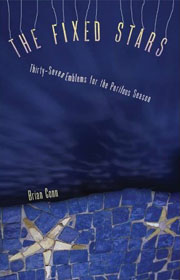Weird Lens of the Unconscious: An Interview with Brian Conn
 Brian Conn’s novel The Fixed Stars is a braid or a maze of fragments that together create an apocalypse, or an illusion thereof. It operates in turns as horror novel, as dystopia, as utopia, as Star Trek/Shakespeare pastiche, and also other modes, with language at once rock hard and dream-logicked. It was one of the most beautiful, challenging books published in 2010, and it didn’t get the attention it deserved. You should really and actually buy it. He is also the co-editor, with Joanna Ruocco, of Birkensnake, one of the more adventurous and interesting-to-touch journals available online and in print.
Brian Conn’s novel The Fixed Stars is a braid or a maze of fragments that together create an apocalypse, or an illusion thereof. It operates in turns as horror novel, as dystopia, as utopia, as Star Trek/Shakespeare pastiche, and also other modes, with language at once rock hard and dream-logicked. It was one of the most beautiful, challenging books published in 2010, and it didn’t get the attention it deserved. You should really and actually buy it. He is also the co-editor, with Joanna Ruocco, of Birkensnake, one of the more adventurous and interesting-to-touch journals available online and in print.
Brian was kind enough to talk with me at length about the ways we sort fiction, how he perceives character and voice, and other things.
* * *
MM: You wrote, in a blog comment I can no longer find, that you feel many of the major stories now seen as “literary” or “mainstream” and often offered as examples in creative writing classes, were actually very experimental works that created their own genre, and that these have only been elevated to/claimed as official literary works after the fact. I think you were responding to a post about The Things They Carried at the time, which I see as a good example. Another one that I might suggest would be Kafka’s The Metamorphosis, which hasn’t been as tamed and integrated as The Things They Carried, but is often offered as a model or set of rules of how certain stories ought to be written. His story “In the Penal Colony” also spawned a sort of mini-genre, I think, but it’s a weirder story and so it hasn’t really gotten the same treatment. Have I butchered your argument or would you like to further refine it? Do other examples come to mind?
BC: I do remember saying that at some point, and also forget where. The examples you mention are good ones, but it actually seems to me that literally every great (whatever that means) story is radically experimental in its own way. Last week I reread “The Dead,” which I usually think of as pretty straight, but even that gets bizarre once you start looking at it — for example the way various characters’ voices are continuously fading subtly in and out, so that even though there appears to be an omniscient narrator it’s hard to find a single line that’s purely in that narrator’s voice, and instead the whole narrative is sort of floating on this shifting sea of character voices.
I mean, what is a canonical “normal” story today? Hemingway? “A Good Man is Hard to Find”? But those are totally weird, right? “The Lottery”?
Interview with Brian Conn
 At Raintaxi, there’s an interview with Brian Conn, author of The Fixed Stars, a really wonderful novel—an anthropology of late capitalism, its language and myths. Conn answers Jedediah Berry’s questions about writing the book–structural choices, influences (including Cosmicomics, Marie Redonnet, Brothers Grimm), the interplay of language and math.
At Raintaxi, there’s an interview with Brian Conn, author of The Fixed Stars, a really wonderful novel—an anthropology of late capitalism, its language and myths. Conn answers Jedediah Berry’s questions about writing the book–structural choices, influences (including Cosmicomics, Marie Redonnet, Brothers Grimm), the interplay of language and math.
Conn wrote about half the book during a summer alone in Hawaii. Of that time he says,
After I finished a section I would wander around for several days trying to think of some event or voice or revelation that would, in some poorly comprehended yet very particular way, contradict everything that I’d already written. I’d discard idea after idea, and then at some point I’d think of an idea and laugh out loud, suddenly and involuntarily, and this idea would be the basis of the next section.
I now think of that summer as a time of intoxicating creativity, and simultaneously of terrifying confusion and despair. I’m sure these two impressions are closely related. I can see the causality flowing in either direction: maybe creativity is actually deeply terrifying, maybe confusion and despair forced me to abandon my usual thinking and reach for something new. Maybe both.
